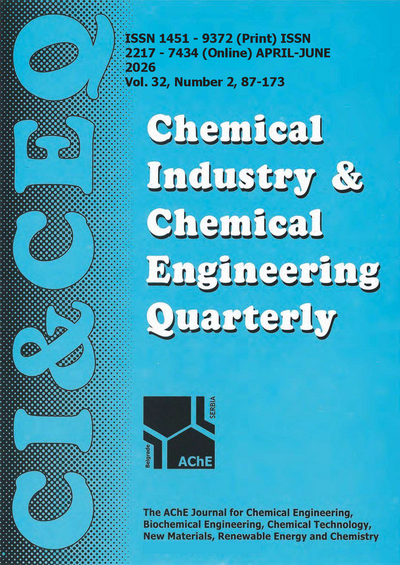APPLYING DENSITY FUNCTIONAL THEORY TO PREDICT THE REDUCTION POTENTIAL IN THE INDIGO DYEING PROCESS
Original scientific paper
DOI:
https://doi.org/10.2298/CICEQ250317020AKeywords:
indigo dyeing, iron(II) salts, DFT calculations, experimental results, complexation energyAbstract
This study employs density functional theory (DFT) to quantify the electron donor-acceptor properties and polarizability of organic iron(II) salts as reducing agents in indigo dyeing processes. The potential of some iron(II) salts to serve as environmentally friendly alternatives to the ecologically harmful sodium dithionite in the indigo dyeing process was investigated. A comparative analysis assessed the redox potential of reduced indigo and the color strength of dyed fabrics. Experimental results identified iron(II) gluconate as the most efficient, yielding superior color intensity. Theoretical calculations using B3LYP/LANL2DZ confirmed the superior electron-donating ability of iron(II) gluconate compared to the other iron(II) salts. The indigo reduction ability with the iron(II) salts was evaluated on the basis of complexation energies. The theoretical thermodynamic study reveals that the indigo-iron(II) gluconate complex is the most thermodynamically stable, requiring less energy input for its formation compared to the other complexes. Iron(II) salts-to-indigo electron donations in the complexes studied have been revealed by Mulliken charge analysis. These findings highlight the efficiency of DFT-based approaches in accurately predicting the reducing capacity of iron(II) salts and their suitability as eco-friendly alternatives in indigo dyeing applications.
References
[1] M. Abdelileh, A.P. Manian, D. Rhomberg, M. Ben Ticha, N. Meksi, N. Aguiló-Aguayo, T. Bechtold, J. Cleaner Prod. 266 (2020) 121753. https://doi.org/10.1016/j.jclepro.2020.121753.
[2] M. Ben Ticha, N. Meksi, N. Drira, M. Kechida, M.F.Mhenni, Chem. Ind. Chem. Eng. Q. 20 (2014) 463-470. https://doi.org/10.2298/CICEQ130507028B.
[3] M. Božič, V. Kokol, Dyes Pigm. 76 (2008) 299-309. https://doi.org/10.1016/j.dyepig.2006.05.041.
[4] N. Meksi, M. Kechida, M.F. Mhenni, Chem. Eng. J. 131 (2007) 187 193. https://doi.org/10.1016/j.cej.2007.01.001.
[5] N. Meksi, M. Ben Ticha, M. Kechida, M.F. Mhenni, Chem. Res. 49 (2010) 12333-12338.
https://doi.org/10.1021/ie100974.
[6] N. Meksi, M. BenTicha, M. Kechida, M.F. Mhenni, J. Cleaner Prod. 24 (2012) 149‑158. https://doi.org/10.1016/j.jclepro.2011.11.062.
[7] J.N. Chakraborty, R.B. Chavan, J. Fibre. Text. 29 (2004) 100‑109. https://nopr.niscpr.res.in/handle/123456789/22596.
[8] R.B. Chavan, J.N. Chakraborty, Color. Technol. 117 (2001) 88‑94. https://doi.org/10.1111/j.1478-4408.2001.tb00340.x.
[9] V.C. Mudnoor, J.N. Chakraborty, J. Fibre. Text. Res. 45 (2019) 109. http://nopr.niscpr.res.in/handle/123456789/54131
[10] P. Mazumdar, J.N. Chakraborty, Tekstile 62 (2019) 187‑199. https://doi.org/10.14502/Tekstilec2019.62.
[11] C. Li, R. Requist, E.K.U. Gross, J. Chem. Phys. 148 (2018) 084110. https://doi.org/10.1063/1.5011663.
[12] A. Hashemi, P. Peljo, K. Laasonen, J. Phys. Chem. C 127 (2023) 3398-3407. https://doi.org/10.1021/acs.jpcc.2c06537.
[13] N. Naeem, T. Tahir, M. Ans, A. Rasool, R. Aqil Shehzad, J. Iqbal, Comput. Theor. Chem. 1204 (2021) 113416. https://doi.org/10.1016/j.comptc.2021.113416.
[14] J.H. Xin, C.L. Chong, T. Tu, Color. Technol. 116 (2000) 260-265. https://doi.org/10.1111/j.1478-4408.2000.tb00044.x.
[15] P. Kubelka, F. Munk, Zh. Tekh. Fiz. 12 (1931) 593–601. https://www.graphics.cornell.edu/~westin/pubs/kubelka.pdf.
[16] S. Grimme, S. Ehrlich, L. Goerigk, J. Comput. Chem. 32 (2011) 1456–1465. https://doi.org/10.1002/jcc.21759.
[17] A. Abkari, I. Chaabane, K. Guidara, Physica E Low Dimens. Syst. Nanostruct. 81 (2016) 136-144. https://doi.org/10.1016/j.physe.2016.03.010.
[18] J. Zhang, T. Lu, Phys. Chem. Chem. Phys. 23(2021) 20323. https://doi.org/10.1039/D1CP02805G.
[19] S. Tsuzuki, T. Uchimaru, Phys. Chem. Chem. Phys. 22 (2020) 22508–22519. https://doi.org/10.1039/D0CP03679J.
[20] Z.A. Guo, J.Y. Xian, L.R. Rong, H. Qin, Z. Jie, Monatsh Chem. 150 (2019) 1355‑1364. https://doi.org/10.1007/s00706-019-02419-1.
[21] T. Koopmans, Physica 1 (1933) 104-113. https://doi.org/10.1016/S0031-8914(34)90011-2.
[22] P. Senet, Chem. Phys. Lett. 275 (1997) 527‑532. https://doi.org/10.1016/S0009-2614(97)00799-9.
[23] R.G. Parr, L.V. Szentpály, S. Liu, J. Am. Chem. Soc. 121 (1999) 1922‑1924. https://doi.org/10.1021/ja983494x.
[24] P.K. Chattaraj, B. Maiti, U. Sarkar, J. Phys. Chem. 25 (2003) 4973‑4975. https://pubs.acs.org/doi/full/10.1021/jp034707u.
[25] G. Gece, S. Bilgic, Corros. Sci. 51 (2009) 1876-1878.
https://doi.org/10.1016/j.corsci.2009.04.003.
[26] G. Gece, Corros. Sci. 50 (2008) 2981-2992. https://doi.org/10.1016/j.corsci.2008.08.043.
[27] S. Manzetti, T. Lu, J. Phys. Org. Chem. 26 (2013) 473-483. https://doi.org/10.1002/poc.3111.
[28] T. Lu, F. Chen, J. Mol. Model. 19 (2013) 5387-5395. https://doi.org/10.1007/s00894-013-2034-2.
[29] T. Lu, S. Manzetti, Struct. Chem. 25 (2014) 1521-1533. https://doi.org/10.1007/s11224-014-0430-6.
Downloads
Published
Issue
Section
License
Copyright (c) 2023 Maha Abdelileh, Manel Ben Ticha, Nizar Meksi, Hatem DhaouadI

This work is licensed under a Creative Commons Attribution-NonCommercial-NoDerivatives 4.0 International License.
Authors who publish with this journal agree to the following terms:
Authors retain copyright and grant the journal right of first publication with the work simultaneously licensed under a Creative Commons Attribution License that allows others to share the work with an acknowledgement of the work's authorship and initial publication in this journal.
Authors grant to the Publisher the following rights to the manuscript, including any supplemental material, and any parts, extracts or elements thereof:
- the right to reproduce and distribute the Manuscript in printed form, including print-on-demand;
- the right to produce prepublications, reprints, and special editions of the Manuscript;
- the right to translate the Manuscript into other languages;
- the right to reproduce the Manuscript using photomechanical or similar means including, but not limited to photocopy, and the right to distribute these reproductions;
- the right to reproduce and distribute the Manuscript electronically or optically on any and all data carriers or storage media – especially in machine readable/digitalized form on data carriers such as hard drive, CD-Rom, DVD, Blu-ray Disc (BD), Mini-Disk, data tape – and the right to reproduce and distribute the Article via these data carriers;
- the right to store the Manuscript in databases, including online databases, and the right of transmission of the Manuscript in all technical systems and modes;
- the right to make the Manuscript available to the public or to closed user groups on individual demand, for use on monitors or other readers (including e-books), and in printable form for the user, either via the internet, other online services, or via internal or external networks.






